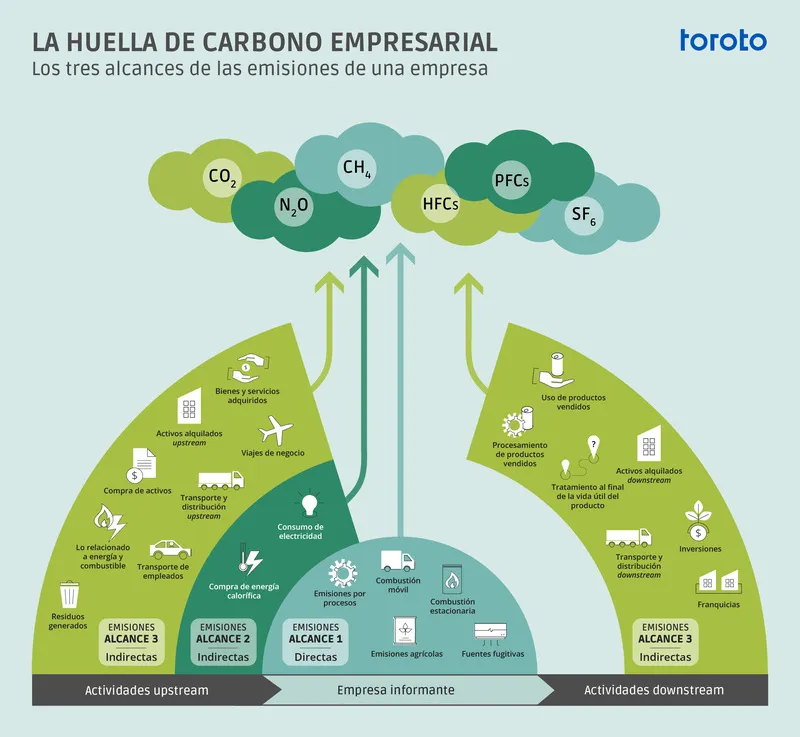One goal, three scopes



This article is part of a series of three. Learn more about Scope 2 hither, and about Scope 3 hither.
Wherever we are, we live surrounded by objects that build our space, our environment, our routine, our culture and our habits. The coffee in the morning, the jeans in the diary, your favorite armchair, the vehicle that moves us, the cell phone or computer in front of you at this precise moment through which you read this text... All objects, but what's behind it?
Some of these objects have the peculiarity of surrounding us (flooding us?) of information: we find them described and explained in documentaries, infographics, movies and social networks, in such a way that the relationship we have with them is shaped little by little, above all, that part of the relationship that leads us to question their origin, the ethics behind their processing and creation, the human and material relationships that exist around it, as well as, -of exceptional importance today- its environmental impact. What effect do terms like fast fashion, slow food, local consumption, water footprint or carbon footprint in your daily life? Terms you've probably heard, read and seen everywhere. Here, and throughout this series of three articles, we will talk about this last term: the carbon footprint.
Everything, everything, everything that surrounds us - much more than just objects - has behind it a carbon footprint constituted by the greenhouse gas emissions released when producing or creating said product or service, and which becomes something inherent to it, since once finished, it leaves behind that “footprint” that encompasses the entire process required - from its creation to its transport - to reach us.
At a corporate level, that carbon footprint is measured through a greenhouse gas inventory, where the emissions associated with the creation of that product or service are property and responsibility of the production company. These emissions can be direct or indirect. Direct emissions are called 'Scope 1' by the GHG Protocol (an international tool used to quantify and report greenhouse gas emissions). On the other hand, indirect emissions are also called Scope 2 and Scope 3 (see Figure 1).
But what are some of the best-known companies doing to deal with their emissions? , what is their impact and what greenhouse gas reduction measures are they carrying out? , how do we begin to take action?
The challenges of measuring and reducing the carbon footprint depend mainly on their origin, and that is why we wanted to start this series -this being the first of three articles- where we will deconstruct this universe, which are greenhouse gas emissions, and we will talk about its parts: Scope 1, Scope 2 and Scope 3 emissions; since it is impossible to reduce them, without first knowing them.
Let's start with Scope 1 emissions.
Figure 1. Classification of greenhouse gas emissions

Scope 1 Emissions: Closer Than We Think
Scope 1 emissions are all those emission sources that are owned or controlled by the company, such as machines, vehicles, air conditioners, power plants, water treatment plants, or, if we are talking about the agricultural sector, the application of fertilizers.
In February 2022, a German company called NewClimate Institute, published a document that assesses the transparency and integrity of the climate commitments of 25 major global companies.
To give context to the economic and environmental impact of these companies, together, the 25 global companies evaluated in this report reported combined revenues of USD 3.18 trillion in 2020, which is close to 10% of the total revenues of the 500 largest companies in the world. On the other hand, its total greenhouse gas emission footprint in 2019, including both direct and indirect emissions, amounts to approximately 2.7 GtCO2e.
What does this mean? Thinking that a gigatonne (Gt) of CO2e is one billion tons of CO2e - that is, a lot - the above is equivalent to 5% of global greenhouse gas emissions in 2019. The really impressive thing about this fact is that this global 5% is produced only 25 multinational companies of the 100,000 transnational corporations that exist in the world (UNCTAD, 2016). It is important to know these figures in order to have a frame of reference, firstly, of the amount of emissions that so few companies can generate, and secondly, to highlight the imminent and urgent need for all of us to move towards a climate strategy.
On the other hand, it is interesting to observe the breakdown of the emissions of each of these companies, since they can be very different sectors from each other. Some range from a technology, transport or energy sector, to a purely logistics sector.
For example, the Deutsche Post DHL group is the world's largest logistics provider. A significant part of their emission sources are their own, that is, they are included in Scope 1. Deutsche Post DHL wants to be a net-zero (or net-zero) company by 2050 and is a pioneer in replacing internal combustion engines. Its reduction measures include replacing part of its fleet with electric vehicles; in such a way that conventional aviation and marine fuels are replaced with sustainable alternatives. On the other hand, they also intend to change part of their long-distance transport to rail transport.
For Scope 1 emissions, the reduction measures may be different from each other. There are those that are based on a technological solution -such as the implementation of electric vehicles- to reduce dependence on fossil fuels, as well as non-technological solutions, such as the implementation of regenerative agriculture -if we are in the agricultural sector-, to restore and improve soil conditions and, through the capture of carbon carried out by it, to compensate for emissions due to the application of fertilizers, to give just one example.
What we want to achieve with the above is that regardless of whether the solutions are technological or non-technological, there are three central aspects to generating a climate strategy that allows us to reduce emissions: first, always The initial step in climate action is the measurement of greenhouse gas emissions, that is, to know and quantify them; secondly, to raise awareness of the absence of a standardized set of measures that everyone can implement to reduce them, given that the emission profiles of companies vary between them, so reducing emissions is a tailor-made job; and finally, that the reduction process does not happen from one moment to the next, but rather involves a gradual development planned in the short, medium and long term.
When in doubt, action!
Mitigating climate change depends on creativity and innovation.
Companies have and will continue to play a central role in finding and scaling up solutions for effective decarbonization. These efforts need urgent acceleration and in Toroto we can help measure and generate an emissions reduction strategy, in order to reduce the climate impact of the companies that produce the objects or services that we all consume.
Change is available to everyone. If we look at those things that are in our control or are our property, such as Scope 1 emission sources are for companies, we can visualize the influence we have on the decisions surrounding those objects and services. On a personal level, it is essential to understand that our actions are important, but the change must be systemic. At the corporate level, it is essential that emissions be identified, measured and reported in order to know how much and what needs to be reduced and then to start with another systemic change, on another scale. Whether we are small or large direct contributors of greenhouse gases, our actions in favor of the environment - both individual and collective - direct us to a global and integrated climate strategy.
A key point of climate strategy, in addition to knowing, quantifying, reducing or mitigating, is to influence others, to generate that change, that need, that strength and passion that we need to act for a future for all. We know that the climate crisis and the impact that our decisions are having on the health of the planet can be paralyzing, but at Toroto we want to help you take action and achieve your company's objectives.
Write to us.
References
United Nations Conference on Trade and Development (UNCTAD). (2016). World Investment Report 2016: Investor Nationality: Policy Challenges. Switzerland.
Explore reflections, research and field learning from our work in ecosystem restoration.